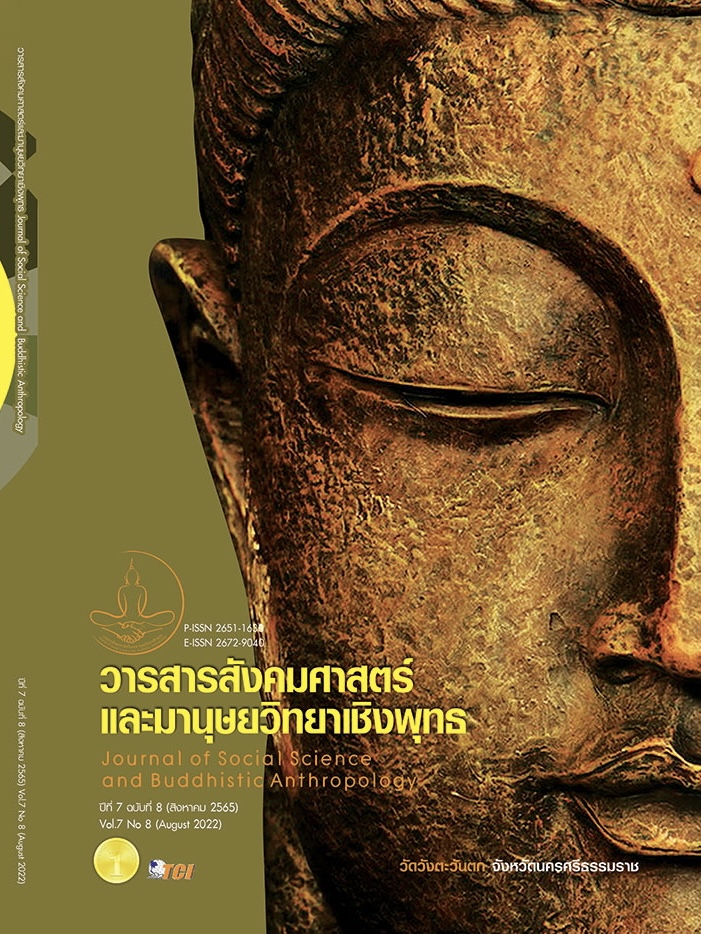DIGITAL MEDIA CREATION POLYGONAL 3D MODELING FOR THE PHAYAO ARTISANS' SANDSTONE INSIDE THE NITHAT CULTURAL HALL, SRI KHOM KHAM TEMPLE, PHAYAO
Keywords:
3D Model, 3D Surface Object, The Phayao Artisans' Sandstone Buddha Images, Nithat Cultural Hall Sri Khom Kham TempleAbstract
The objectives of this research were as to: 1) to study the Phayao Artisans' Sandstone Buddha Images exhibited in the Nithat Cultural Hall, Sri Khom Kham Temple, Phayao Province. 2) to create a digital media polygonal 3D models of the Phayao Artisans' Sandstone Buddha Images by using the 3D surface object techniques (photogrammetry and retopology). 3) to assess participants’ satisfaction with the polygonal 3D models. This research is qualitative research. The group of samples was 100 people who were interested in the Phayao Artisans' Sandstone Buddha Images. The education tools and operations were 1) The polygonal 3D surface object models of Phayao Artisans' Sandstone Buddha Images. 2) The questionnaire of satisfaction for polygonal 3D models of Phayao Artisans' Sandstone Buddha Images. The results showed that 1) The art forms of the Phayao Artisans' Sandstone Buddha Images that found in Phayao Province, most of them were influenced by the Sukhothai Kingdom. Moreover, they can be divided into 5 categories in terms of Buddhist art characteristics. 2) There are 10 pieces of 3D models using polygonal and surface object techniques with text and audio information about detail of characteristics. 3) The satisfaction with the polygonal 3D models of the Phayao Artisans' Sandstone Buddha Images was at a high level. In terms of data and the polygonal 3D models were 3.92 and 3.84 respectively. Moreover, there was 3.76 on the presentation. Finally, the overall satisfaction results were 3.82 that experienced a high level of pleasure.
References
โกญจนาท ศรีกาฬสินธ์. (2544). การนำเสนอผลงานสถาปัตยกรรมการออกแบบในเชิง 3 มิติ. ใน วิทยานิพนธ์วิทยาศาสตรมหาบัณฑิต สาขาเทคโนโลยีสารสนเทศ. มหาวิทยาลัยศรีประทุม.
ณรงค์ พูนพจน์มาศ. (2552). การสร้างแบบจำลองสามมิติของโบราณด้วยภาพถ่ายดิจิตอล. ใน โครงการวิจัยทุนสนับสนุนงานวิจัยของมหาวิทยาลัยเทคโนโลยีราชมงคลกรุงเทพ. มหาวิทยาลัยเทคโนโลยีราชมงคลกรุงเทพ.
นรุตม์ สุนทรานนท์และคณะ. (2558). การสร้างแบบจำลอง 3 มิติจากภาพหลายภาพ สำหรับมรดกทางวัฒนธรรม. ใน รายงานการวิจัย. สำนักงานพัฒนาเทคโนโลยีอวกาศและภูมิสารสนเทศ.
ไพศาล สันติธรรมนนท์. (2555). การรังวัดด้วยภาพดิจิทัล (Digital Photogrammetry). (พิมพ์ครั้งที่ 1). กรุงเทพมหานคร: สำนักพิมพ์แห่งจุฬาลงกรณ์ มหาวิทยาลัย.
วิชา จิวาลัย และปรีชา วงศ์วิทวัส. (2531). การสำรวจด้วยภาพถ่าย. (พิมพ์ครั้งที่ 2). กรุงเทพมหานคร: สำนักพิมพ์แห่งจุฬาลงกรณ์มหาวิทยาลัย.
ศักดิ์ชัย สายสิงห์. (2563). พระพุทธรูปหินทรายสกุลช่างพะเยา. (พิมพ์ครั้งที่ 1). กรุงเทพมหานคร: โรงพิมพ์มติชน.
ศุภชัย โชติกิจภิวาทย์และคณะ. (2564). การศึกษาความเหมาะสมและความพึงพอใจของการจัดการเรียนรู้โดยการบูรณาการการประยุกต์ใช้แอปพลิเคชันด้วยเทคโนโลยีดิจิทัล. ใน การประชุมวิชาการระดับชาติ. วิทยาลัยนครราชสีมา.
ศูนย์มานุษยวิทยาสิรินธร (ศมส.). (2563). พิพิธภัณฑ์ในประเทศไทย หอวัฒนธรรมนิทัศน์วัดศรีโคมคำ. กรุงเทพมหานคร: ศูนย์มานุษยวิทยาสิรินทร (ศมส.).
Habib, A. F. & Ghanma, M. S. (2004). 3-D Modelling of historical Sites Using Low-Cost Digital Camera. ISPRS Journal of Photogrammetry and Remote Sensing, 4(7), 1-6.
Kraus, K. et al. (1993). Photogrammetry Volume 1 Fundamentals and Standard Processes. Germany: WB-Druck 8959 Rieden.
Massimiliano, P. et al. (2001). 3D digitizing of cultural heritage. Journal of Cultural Heritage, 2(1), 63-70.
Downloads
Published
How to Cite
Issue
Section
License
Copyright (c) 2022 Journal of Social Science and Buddhistic Anthropology

This work is licensed under a Creative Commons Attribution-NonCommercial-NoDerivatives 4.0 International License.








